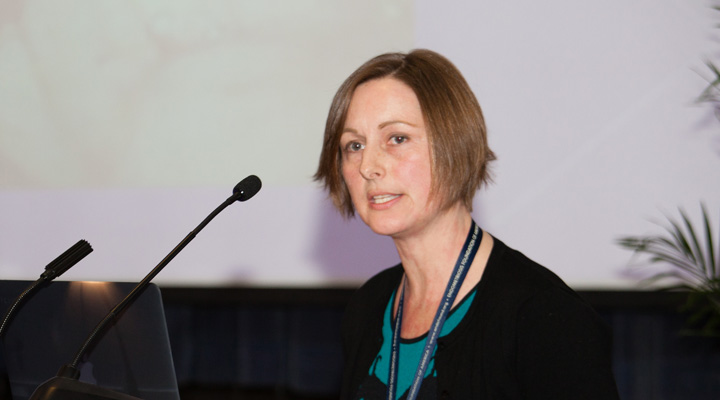Endofound’s Sixth Annual Medical Conference: Ending Endometriosis Starts at the Beginning
Moving from “it is all in your head” to early surgical intervention
Melanie Marin, MD
I would like to start by saying that I am a clinician and a surgeon. For the past 18 years I have just been seeing patients and doing surgery. I do not do research and generally do not give talks but Dr. Harry Reich who taught me in the operating room 20 years ago asked me to speak and I am never going to say no to him. So here I am. He taught me back then to evaluate endometriosis with a rectal exam, find every little piece, know where it is, do it again during surgery. He taught me to make three little tiny incisions. He taught me to operate with both hands. I still use scissors to take everything out with cutting current so there is no spread. Here I am and I owe him thanks again because he invited me to this conference and it has been such a great experience.
I submitted this as the title of my talk (It’s not in your Head) and when I got the program I found that this is the title of my talk (Moving From “It is all in your Head” to Early Surgical Intervention). So I want to be clear that while I love doing surgery and I believe that surgical excision of endometriosis is an important tool I do not think that every woman who has endometriosis needs to have surgery. If you have pelvic pain, thought to have endometriosis and you are put on the pill and your symptoms go away I do not think you necessarily need to have surgery. However, for women who are not controlled with the pill surgical incision can be life changing and lifesaving practically. So that is for the woman who is undiagnosed, told that she is exaggerating, that it is only her period or does not know what is wrong, or that it is all in her head, laparoscopic surgery is vital for that woman.
What is chronic pelvic pain? ACOG defines it as cyclic or continuous pain that occurs for six months or longer. Seventy percent or more of women with chronic pelvic pain have endometriosis. And yet still the average time it takes for a woman to get diagnosed is seven years or more. During that time chronic pain is adversely affecting the nerves, the muscles and even the skeletal system. When we feel acute pain our nerves fire and even before our brain registers the pain our bodies respond. We remove the stimulus and the pain disappears.
But what happens when we cannot get away from the source of the pain because it is coming from our own bodies? And worse, what happens when we do not even try to get away from the pain because we are told it is all in our head? The chronic stimulation of the nerves continues. The nerves do not have the opportunity to relax and reset so they become hypersensitive and hyper-responsive. We heard a little bit about that from Ms. Bush yesterday and today as well. If the pain is felt more acutely it is felt for a longer period of time because the nerve just continues to fire. If it goes on long enough even removing the stimulus does not remove the pain. The changes of chronic pain have set in and this is called long term potentiation and it is exacerbated by inflammation. Endometriosis causes both pain and inflammation so we have a double whammy.
Fascinatingly, studies in rats suggest that those changes of long term potentiation start in as little as three hours. So what does seven years of that do to somebody? That is what it does. Our nervous system becomes hypersensitive, our muscles spasm, our posture changes, our gait is altered. We put different stresses on our ligaments and joints because we walk differently and sit differently. We cannot sleep because we are in pain. We become anxious because we do not know what is wrong with us and we cannot sleep. Lack of sleep and anxiety increase the perception of pain and the vicious cycle just continues and continues. It becomes hard to work and we become socially isolated and we lose self-esteem. And that is not even bringing up having sex or having a relationship with somebody else. It is a hot mess. It is a pretty dismal picture and every single one of us who treats endometriosis has seen it. Early recognition of endometriosis and intervention to remove the source of pain before this chronic cycle starts is crucial. The ideal is to hear the woman, actually hear her, in pain and move quickly to diagnose the problem. If medical management relieves the pain – great – problem solved. However, if not, in the minority of women that the chronic pain is not due to endometriosis diagnostic laparoscopy can rule it out and then you can move on and find the right course.
In the 70 percent of women with chronic pain who have endometriosis the operative laparoscopy with the resection of disease is the only place to start. If found early enough it can prevent the long term devastating physical and emotional changes that can literally ruin a life.
This patient came to me in 2004 at the age of 17. She was failing out of school because she was incapacitated for 12 days of the month with chronic pain. She also had a diagnosis of bipolar disorder and depression and she was told she was exaggerating her pain. She was hysterical. She was trying to get out of school. It was due to her psychiatric problems. Her mother is an impressive woman and would not accept this conclusion from her daughter’s doctors. When I met her she was sitting in a chair crunched in a little ball of pain. When we did the laparoscopy it looked like this. Sort of looks pretty good a first glance and I think if she had gone to a different doctor, to a general gynecologist, she might have been told that it was all in her head and sent away. But I had examined her with a rectal exam and knew that her uterosacral ligaments were thick, were tender. She jumped off the table when we examined them and I knew from the operating room that there was not a lot of other nodularity there and then of course when we looked in this is what it looked like. We looked everywhere, made sure the peritoneum was smooth and clear everywhere and could move. Then took out her uterosacral ligaments and they were both endometriosis.
She is now 28 years old. She has been on the pill since that surgery. She finished high school, finished college, has no pain for the past 11 years and is working in a career that she loves.
In contrast I had this woman and that is the uterus there, which is the only part of the pelvis that you could see. She did not have any pain. She had a little bit of cramping and had an ultrasound by another doctor and had two huge ovarian cysts. They were endometriomas. She had a pretty complicated medical history as well including Lupus and some heart disease. She came to me for her surgery. We dissected everything out and took out the cysts. She has been on no hormonal intervention since and it has been 11 years with no pain.
Why this woman had no pain and this woman had a lot of pain is something that we do not understand as we have been saying. But would you not rather take out the disease when it looks like this than when the patient is 30 and it looks like this? I would.
If this is not you, if you ended up here, all is not lost. Get a good doctor, someone who will listen to you, someone who knows how to treat the endometriosis and take care of the endometriosis. If you have adenomyosis you might need a hysterectomy included. Find someone who knows how to treat the problems after the surgery and the problems that the chronic pain left behind. You can use any or all of these modalities. Every step you take to ratchet down the pain brings you back closer to a normal life. You can use the pills, the Mirena IUD, Depo-Provera, Lupron to control the hormones, NSAIDS to treat the inflammation, SSRIs and SSNRIs can help stop the pain fibers from firing once the chronic pain has set in. Tricyclic antidepressants can do the same thing. Anti-seizure medications like Neurontin can also work to quiet those hyperactive nerves once you have chronic pain. You might need physical therapy to get those muscles to relax again. You might need physical therapy to teach you how to sit right and stand right and walk right again so the pain does not continue. Acupuncture helps chronic pain of any cause. Biofeedback can help you learn to retrain your muscles and your nerves. Every step you take helps ratchet down the pain a notch every way you can.
It is not in your head, it is in your pelvis and it can be treated. Thank you.










